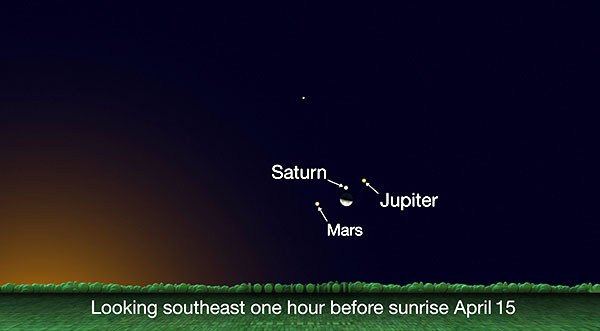WHAT’S UP: April 2020 Skywatching Tips From NASA, Seven Sisters Meet the Evening Star
By Space Coast Daily // April 6, 2020
What's Up for April at NASA?
ABOVE VIDEO: What’s Up for April? The Seven Sisters meet the evening star, Mars continues its getaway, and unpacking the Moon illusion.

(NASA) – What’s Up for April? The Seven Sisters meet the evening star, Mars continues its getaway, and unpacking the Moon illusion.
At the beginning of April, look to the west each evening in the couple of hours after sunset as Venus visits the Pleiades.
This should be spectacular if the weather’s clear where you are, so here’s wishing you clear skies.
The planetary quartet of Jupiter, Saturn, Mars and the Moon once again make a showing in mid-April. Since giving Jupiter and Saturn the slip last month, the Red Planet continues its getaway from the gas giants in this month’s morning skies. Mars begins the month just beneath Saturn, but by the middle of April, it’s moved a decent distance away.
The Moon swings by on the 14, 15 and 16. The three planets won’t appear close together in the sky again for a couple of years, so catch them now if you can!
Earth is currently catching up to Mars in its orbit, as the two planets come into the right position for the launch of NASA’s Mars 2020 mission and its newly named Perseverance rover.
Most of us have had the experience of watching the full moon rise in the distance, maybe over a city or a distant mountain, and it looks HUGE.
In fact, it’s got the very appropriate (if unimaginative) name of “the Moon illusion.” Although this illusion has been known for thousands of years, there still isn’t a truly satisfying scientific explanation for why we see it.

Now the Moon is essentially the same width in the sky on any specific night, whether it’s rising, setting or overhead. (There are a variety of experiments you can do to prove this for yourself.)
Photographers can simulate the Moon illusion by taking shots of the moon low on the horizon using a long lens with buildings, mountains or trees in the frame.
It’s known not to be an optical effect of our atmosphere, though the atmosphere does add to the yellowish color of the rising and setting Moon, much as it makes the rising and setting Sun look redder.
Even airline pilots and astronauts have reported seeing the moon illusion — in the absence of trees, buildings and mountains to help provide a sense of scale.
Researchers have shown that it’s definitely something going on in our brains that has to do with the way we perceive the size of distant objects near the horizon, versus high in the sky, but the precise explanation for why it happens is still elusive.
So until someone puzzles out exactly what our brains are up to, it’s probably best to just enjoy the Moon illusion, and the moody, atmospheric and sometimes downright haunting vistas it creates.
Here are the phases of the Moon for April.
You can catch up on all of NASA’s current and future missions at nasa.gov. I’m Preston Dyches from NASA’s Jet Propulsion Laboratory, and that’s What’s Up for this month.














